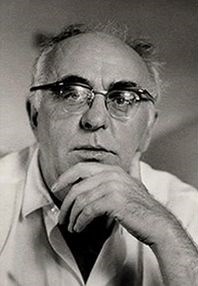Charles Olson
 Charles Olson (27 December 1910 – 10 January 1970) was born to Karl Joseph and Mary Hines Olson in Worcester, MA, where Charles’ father worked as a mailman. During his childhood years, the Olson family summered in Gloucester, MA – a place which later became the focus of his writing. In high school, Olson was a champion orator, winning a European tour for his abilities.
Charles Olson (27 December 1910 – 10 January 1970) was born to Karl Joseph and Mary Hines Olson in Worcester, MA, where Charles’ father worked as a mailman. During his childhood years, the Olson family summered in Gloucester, MA – a place which later became the focus of his writing. In high school, Olson was a champion orator, winning a European tour for his abilities.
He attended college at Wesleyan University in Middletown, CT where he studied Literature and American Studies, receiving both a Bachelor and Masters of Art. After teaching English for two years at Clark University in Worcester, Olson entered Harvard University in 1936, completing his coursework for a PhD in American Civilization but failing to complete the degree. Olson received a Guggenheim Fellowship in 1939 to work on a book on Herman Melville which was eventually published in 1947 under the title Call Me Ishmael. During World War II, Olson worked in the Foreign Language Division of the Office of War Information and later served as adviser and strategist for the Democratic Party’s National Committee but preferred the independence of a writer. He took a brief teaching position at Black Mountain College in 1948 and later served as rector of the school until its closing in 1956. At that point, he returned to Gloucester where his main focus became the Maximus series.
In Gloucester, he chose to live in relative isolation and poverty, leaving only for two brief teaching stints at SUNY Buffalo and University of Cincinnati respectively. Olson died of cancer in New York City, two weeks past his fifty-ninth birthday, having completed the Maximus Poems only a month before. He had two common-law marriages: the first to Constance Wilcock with whom he fathered a daughter, Katherine; the second to Elizabeth Kaiser who bore him a son, Charles Peter. Writing autobiographically, he described himself not so much as a poet or writer but as “an archaeologist of morning” (Collected prose 206). The phrase has remained as a common descriptor for him.
Olson’s critical review of Herman Melville’s Moby Dick, entitled Call Me Ishmael, is widely recognized as a classic in the field of literary criticism. Originally publishing in 1947, it has been republished three times and has received much attention for both its poetic style and its experimental organization. In the book, Olson explores the influences on Melville’s writing –particularly Shakespearean ones—and posits what has become known as “the theory of the two Moby-Dicks”.
For his poetry, Charles Olson has come to be recognized as a major influence in the shaping of postmodern American poetry. He is recognized as a chief successor to Ezra Pound and William Carlos Williams and a leading voice of the New American Poets—a designation which includes the Black Mountain, New York School and San Francisco Renaissance groupings. His place in literary history seems assured by such achievements as his epic series, the Maximus Poems (1953-1975), the theoretical manifesto “Projective Verse” (1950), and essays such as “Human Universe” (1951). Warren Tallman, in his preface to The Poetics of the New American Poetry (1973), refers to the postmodern poets of the fifties and sixties as “Olson’s generation”.
The Maximus Poems are generally regarded as Charles Olson’s major work. They were written over a period of almost twenty years and contain more than 300 poems, varying in length from a single line to ten pages. Considered as an epic of place, the poems specifically concern the city of Gloucester where Olson settled in 1950. The town serves to represent the communal American life that Olson struggled to preserve. Several of the poems take up local issues such as preserving the wetlands and documenting the history of fishermen in the Northeast. Dogtown, the wild, rocky center of Cape Ann, is also an important place in the Maximus Poems. Olson used to write outside on a tree stump in Dogtown. Olson backed up these poems with his own social action — working towards the preservation of historic buildings and local wetlands on his beloved Cape Ann.
Between mid-December of 1962, and his death on January 10, 1970, Charles Olson wrote a total of seventeen letters to the editor of the Gloucester Daily Times. Five of these communications were in the form of poems; the remaining twelve were prose letters. The five poems are included in The Maximus collection. Olson’s letters to the editor of the Gloucester Daily Times parallel certain poems in the Maximus sequence in terms of subject or focus. Olson deals with many of the same subjects or issues, though sometimes differently, in his letters to the editor. Indeed, the letters to the editor should be considered as a corollary text and studied as such. But the letters are also “an attempt to call the people’s attention to a number of pressing issues, from the city’s seeming amnesia regarding her greatest painter, Fitz Hugh Lane (now Fitz Henry Lane), to the consequences of the razing of precious buildings, by urban renewal, or what Olson referred to as ‘renewing without reviewing.'” (see Anastas)
Olson began work on the Maximus Poems in the mid-1940s and continued to expand and revise them until his death in 1970. Some poems stand independently, others depend for their meaning on their context within the series. The Maximus Poems are divided into three volumes, meant to be read as a long, single poem–Olson refers to it as such. The last of the three volumes imagines an ideal Gloucester in which communal values have replaced commercial ones. When Olson knew he was dying of cancer, he instructed his literary executor Charles Boer and others to organize and produce the final book in the sequence.
CHARLES OLSON COLLECTION
The Library maintains a collection of over 100 volumes by and about Charles Olson. The collection contains most of Olson’s poetry and prose, correspondence and interviews with the author and a wide variety of biographical and critical texts. The entire collection is housed in the Local History section and may only be used within the library. However, duplicates of many of the volumes are located on the Gloucester Shelf and may be checked out.
See what is available in the NOBLE collection:
Works by Charles Olson
Works about Charles Olson
MAXIMUS TO GLOUCESTER
The following letters and poems were written by Charles Olson to the editor of the Gloucester Daily Times (1962-1969) which is available on microfilm in the Local History section:
-
- ‘A Beef’ About Homer, Stamp 12/22/1962
- Poet Salutes Painter 10/16/1965
- A Scream to the Editor 12/3/1965
- Poet proposes Gloucester restore selectmen 12/28/1965
- To the Editor of the Gloucester Times 1/3/1966
- DEAR GLOUCESTER (via the Editor of GDT) 1/22/1966
- Save Morse house 8/8/1967
- Poet appeals to Gloucester land owner 10/25/1967
- Poet begs for action to save beauty 1/18/1968
- Poet pleads for appreciation, preservation 1/27/1968
- Poet takes a Gloucester walk 1/12/1968
- ‘Light sits under one’s eye…’ 9/4/1968
- ‘Restore the 10 Lb. Island House’ 10/28/1968
- “MAGNIFICANTE” 11/26/1968
- ‘Isn’t enough of her folk in counsel’ 1/29/1969
- ‘…handsome ex-town hall’ 4/7/1969
- Poet pleads for Essex Ave. ‘patch’ 5/30/1969
ONLINE RESOURCES
-
- Back to Geography: A Discussion of Charles Olson’s “Maximus, to Gloucester, Letter 27” Hosted by Al Filreis and featuring poets Charles Bernstein, Rachel Blau DuPlessis, and Bob Perelman.
- Charles Olson, 1910-1970. This online biography of Olson by the editors of Poetry Foundation contains excellent bibliographies of works by and about Charles Olson as well as links to Olson’s works published online.
- Charles Olson reading Maximus to Gloucester, letter 27. A short video of the author himself reading letter 27.
- Charles Olson Society. Internet anthology of minutes of the Charles Olson Society, a scholarly journal published by Ralph Maud in Vancouver, Canada.
- Charles Olson in Gloucester. A short memoir of Olson written by Gloucester author, Peter Anastas.
- Gloucester HarborWalk – 03 Charles Olson
- Poets.org - Charles Olson
- University of Connecticut, Charles Olson Research Collection
- University of Pennsylvania. PennSound, Charles Olson
- Polis is This: Charles Olson and the Persistance of Place: Documentary directed by Henry Ferrini about the life of Charles Olson






